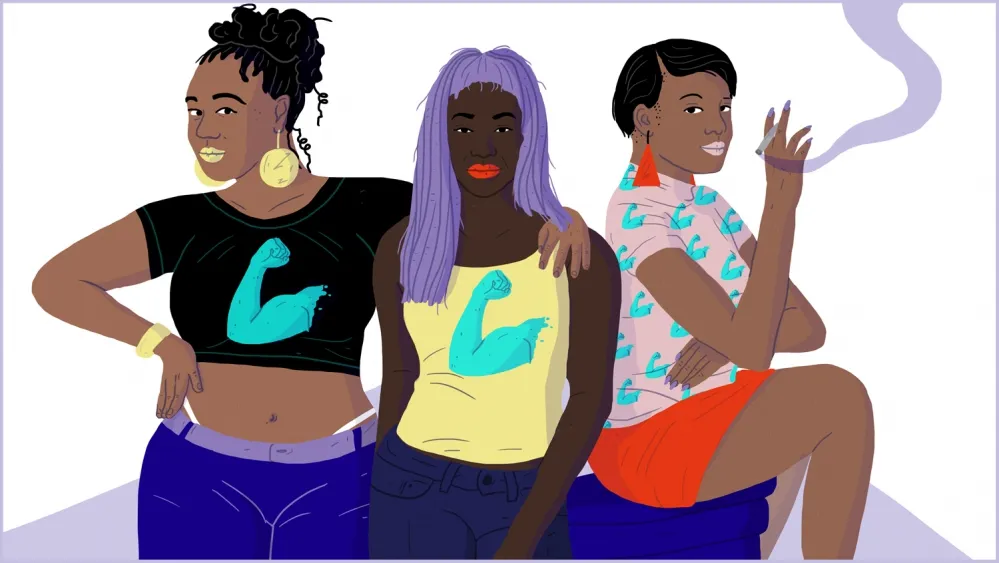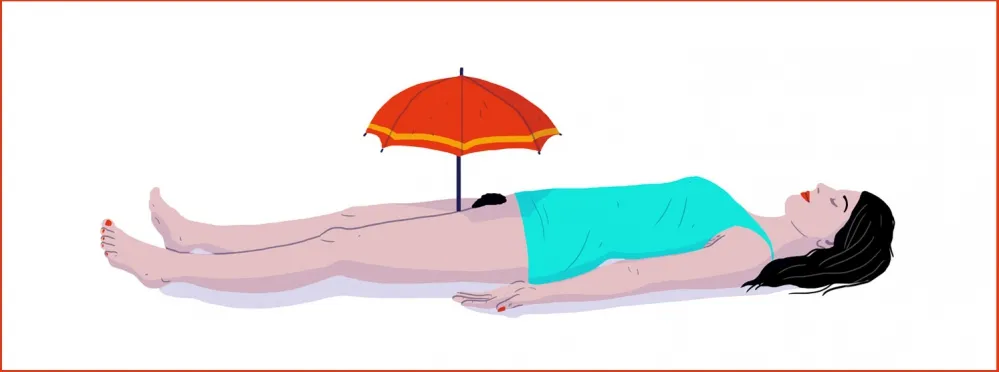The aisle is marked with a little red sign that says “Feminine Treatments”. Squeezed between the urinary incontinence pads and treatments for yeast infections, there is a wall of bottles and packages in every pastel shade imaginable. Feminine deodorant sprays, freshening wipes, washes for your “intimate area”.
Vaginal odour might be the last taboo for the modern woman. I’ve actually driven to the SuperTarget two towns away from where I live so as to not run into anyone I know while scrutinising the various products that exist for cleansing, deodorising and re-balancing the pH of your vagina (I still bumped into another PTA mom in a neighbouring aisle).
The companies behind these products know that many women are looking for ways to counter embarrassing and debilitating symptoms such as vaginal odour and discharge. The culprit is often bacterial vaginosis, the most common vaginal infection you’ve probably never heard of. Nearly one-third of US women of reproductive age have it at any given time. The sad truth is that these sprays, soaps and wipes will not fix the problem. They will – in many cases – actually make it worse.
But while women try to mask embarrassing smells, a more sinister truth also remains under cover: the bacteria responsible are putting millions of women, and their unborn babies, at risk from serious health problems. All of which is making researchers look anew at the most private part of a woman’s body, to understand what it means to have a healthy – some prefer “optimal” – vagina and why that is so important for wider health.

Compared with those of other mammals, the human vagina is unique. As warm, moist canals exposed to all sorts of things including penises, babies and dirt, most mammalian vaginas harbour a diverse mix of bacteria. However, for many women, one or another species of Lactobacillus has become the dominant bacterial resident.
Lactobacillus bacteria pump out lactic acid, which keeps the vaginal environment at a low, acidic pH that kills or discourages other bacteria, yeast and viruses from thriving. There are even hints that certain Lactobacillus species reinforce the mucus in the vagina that acts as a natural barrier to invaders.
Although no one knows for sure, researchers speculate that human vaginas gained their Lactobacillus protectors around 10,000–12,000 years ago when humans began fermenting milk and eating foods like yoghurt and cheese, which are full of the bacteria.
Certain Lactobacillus may have expanded their territory to colonise the vagina – travelling the short distance from the anus to the vaginal opening. There, they found their perfect environment, a low-oxygen chamber that, during a woman’s reproductive years, has an abundant supply of the sugars Lactobacillus feed upon.
For the most part, we’ve been happily cohabitating ever since, but it’s a delicate balancing act. Normal intrusions to the vaginal environment, such as semen (which causes vaginal pH to rise) or menstruation, can reduce numbers of Lactobacillus and allow other microbes, including those associated with bacterial vaginosis (BV), to flourish.
Tammy’s BV started just a few weeks after she had her hormonal intrauterine device inserted.
Like many women, Tammy* – a 37-year-old from a suburb of St Louis, Missouri – was recommended the device for birth control by her doctor after she had her first child. After a few weeks, she noticed some worrisome symptoms: increased vaginal discharge and a fishy smell. Tammy thought she had a yeast infection and took over-the-counter medications, but when it didn’t clear up she headed back to her gynaecologist’s office.
BV rubs salt in the wounds of health inequality, affecting African American, Hispanic and Mexican American women more than white women
Her doctor explained that BV is a disturbance of the natural balance of bacteria that live inside the vagina. Sex with someone new, having multiple partners, and douching – rinsing out the vagina with a bag or bottle of liquid – can all contribute to getting BV, but it is not classified as a sexually transmitted disease. Mostly, how a woman develops BV is still a big mystery.
Tammy’s doctor treated her with a week of antibiotics, the standard treatment, and her BV cleared up. But, as happens to roughly half of the millions of women in the US who have BV at any given time, Tammy’s infection kept coming back. “I was getting it once or twice a month, which was too much for me as a PE teacher and coach,” she says.
“When it’s going to come up on you and the smell is ridiculous, you just had to make sure you were always prepared with cleansing wipes, spray and sanitary napkins,” she says. If it happened and you weren’t prepared, it would be “a horrible day”.
And if the embarrassment and discomfort weren’t enough, BV has a far more menacing side. Women affected have a higher risk of contracting sexually transmitted infections (STIs) like gonorrhoea and chlamydia, acquiring and transmitting HIV, and having pelvic inflammatory disease (which can lead to infertility) and other vaginal and uterine infections. During pregnancy, BV gives a woman a greater chance of having a preterm birth or passing infections to her baby, both of which can lead to lifelong problems for the baby.
What’s more, BV rubs salt in the wounds of health inequality, affecting African American, Hispanic and Mexican American women more than white women, poor women more than rich women, and uneducated women more than educated women in the US.

Tammy is currently pregnant with her third child. She’s not worried, however, because she’s so familiar with BV now that she knows the first signs and gets treated immediately. But approximately half of women with BV have no symptoms and don’t even know they have a problem, let alone one that’s putting them in harm’s way. For many, they believe that’s just the way their vagina is.
Before her intrauterine device, Tammy had never had a problem with BV. She got the standard hygiene lecture from her gynaecologist, Denise Willers: External washing of the vulva should only include water, or a mild, non-foaming soap. No scents, perfumes or bubble baths. Take showers, not baths. And douching? Absolutely not!
Douching of any kind disrupts the balance of good bacteria and is associated with increased risk of BV. Folklore about the need to clean out the vagina – especially after sex or a period – is often handed down from older relatives to younger women. But the vagina is remarkably adept at taking care of itself if left undisturbed.
“Your vagina is like a self-cleaning oven,” says Willers. It doesn’t need any special help.
§
When Sharon Hillier joined King Holmes’s laboratory at the University of Washington in Seattle in 1982, BV was called “non-specific vaginitis”. “What kind of crazy name is that?” Hillier says. It was a catch-all diagnosis given to women who had vaginal infections of unknown origin – not yeast infections or common STIs like chlamydia or trichomoniasis.
The mystery drew Hillier in. She knew she needed to stay in the field when, during one brainstorming session with mostly male colleagues, someone suggested that women with BV were sexually repressed or feeling sexual guilt. This idea was “completely crazy” to Hillier.
“A fishy odour was considered to be so common and meant you were a woman who had too much sex or the wrong kind of sex. It created tremendous amounts of concern for women,” and still does today, says Hillier, now a microbiologist at the University of Pittsburgh. “It gets to the core of how we feel about ourselves.”
The Holmes lab did much of the early work to describe, and eventually name, BV. In the early 1970s, it was apparent to Holmes that BV was one of the most common reasons women came to the OB/GYN clinic. At that time, the treatment was a vaginal cream that Holmes thought was “almost useless”. In 1978, he had a colleague, Terrence Pheifer, run a clinical trial to find out if oral antibiotics worked better. They didn’t, but serendipity struck during the trial.
BV increases a woman’s risks of contracting all other STIs, going into preterm labour, and having other pregnancy complications
A woman came in with both an STI and signs of BV. The protocol was to treat the infection first with the antibiotic metronidazole before giving other drugs for BV. “Lo and behold, her BV went away,” Holmes says. They immediately substituted metronidazole into the study and showed that it cleared up almost every case of BV. Nearly 40 years later, it’s still the treatment of choice.
Around the same time, members of Holmes’s lab were figuring out how to diagnose BV. Richard Amsel had noticed that besides discharge, women with BV had vaginal fluid that was less acidic and had “clue cells” – cells decorated with bacteria – in their vaginal swabs.
Pheifer stumbled upon a third criterion, the “whiff test”. He brought a test-tube of vaginal fluid from a patient with BV into Holmes’s office and added a few drops of potassium hydroxide. “A really foul, abnormal odour was instantly released from the fluid,” says Holmes. His colleague next door, a biochemist, wandered over and remarked, “Aha, amines!” The bacteria had released chemicals named putrescine and cadaverine, after their pungent smells.
Holmes felt the syndrome should be renamed bacterial vaginosis, which loosely translates to “too much bacteria”. And fulfilling three of the four Amsel criteria – thin vaginal discharge, vaginal pH greater than 4.5, positive whiff test and clue cells – is still used by many doctors today to diagnose BV.
In 1995, Hillier and a young medical resident, Craig Cohen, showed that HIV and BV were intimately entwined: sex workers in Thailand who had BV were four times as likely to be HIV positive as those without BV. Since then, epidemiologists have also found that having BV increases women’s risks of contracting all other STIs, going into preterm labour, and having other pregnancy complications.

A renaissance in BV research is afoot since the Holmes lab’s heyday, thanks largely to the ease and speed with which the bacteria living in the vagina can be genetically sequenced and identified. Researchers can now catalogue entire bacterial communities, or microbiota, and begin to sort out what happens inside healthy vaginas and what goes awry in BV.
They are realising that all Lactobacillus bacteria – long thought to keep vaginas healthy – are not created equal. For some researchers, L. crispatus is emerging as the vagina’s superhero. It not only pumps out the best mix of two different types of lactic acid to keep the vagina inhospitable to other bugs, but it also fortifies a woman’s vaginal mucus to trap and keep at bay HIV and other pathogens.
To confuse matters further, some of the vaginal villains deemed the culprits in BV, Gardnerella, Prevotella and Atopobium, have been found in the vaginas of healthy women.
In 2011, Larry Forney, an evolutionary ecologist at University of Idaho in Moscow, and Jacques Ravel, a microbial genomicist from the University of Maryland School of Medicine in Baltimore, sequenced the bacterial species found in the vaginas of nearly 400 North American women who didn’t have the symptoms of BV. They found five different types of bacterial community. Four of these were dominated by different Lactobacillus species, but the fifth contained a diverse mix of microbes (including Gardnerella, Sneathia, Eggerthella and Mobiluncus species), many of which have been associated with BV.
It came as a surprise to find that there were several different kinds of healthy vaginal microbiota – including one that wasn’t dominated by Lactobacillus at all.
When Ravel and Forney sorted their results based on the women’s ethnicities they got another surprise. For each ethnic group, there was one bacterial community that was by far the most common, present in roughly 40 per cent or more of those women.

For white women, it was the community dominated by L. crispatus. For Asian women, it was the one dominated by L. iners. For black and Hispanic women, it was the diverse one. These community differences may explain why black and Hispanic women have higher rates of BV. But Ravel contends that we still don’t fully understand what determines vaginal health.
Ultimately, it probably comes down to the functions each bacterial species performs in the vagina with its mix of neighbours, he says. “All of those microbiota [communities] might be very healthy.” However, he concedes that the diverse community type, though found in many healthy women, could still carry higher risks.
Forney’s also not convinced that vaginal health is as simple as having Lactobacillus and an acidic vagina. For one thing, young girls and post-menopausal women have much less acidic vaginas, which are still healthy.
“All kinds of things – lubricants, semen, bacteria, faeces – get put into the vagina,” says Forney. “But most women are healthy most of the time.” He and other microbiologists would like to discover the keys to that resilience, which probably relies on interactions between the vaginal wall cells, the microbes living there, and the woman’s immune system.
§
In 2006, reproductive epidemiologist Jenifer Allsworth set out to determine just how many women in the US were affected by BV. Crunching data from a national health survey and 3,727 vaginal swabs analysed by Hillier’s group, Allsworth showed that 29 per cent of all US women aged 14–49 were positive for BV. At the time, that represented a staggering 19 million women.
When Allsworth broke down the data by race, only 23 per cent of white women were positive for BV, compared with nearly one-third of Mexican American women and over half of African American women.
Her analysis also showed that BV rates were higher in women whose education had stopped at or before high school, and in women whose family income was near or below the federal poverty level. The infection was much more common in women who had douched in the last six months – and, somewhat surprisingly, it was present in 15 per cent of women who reported never having had sex.
That shows that BV is a “natural process” on some level, says Allsworth, now at the University of Missouri-Kansas City School of Medicine. Even so, she calls the much higher rates of BV in certain groups “pretty shocking”. What might account for these differences? She says we don’t know yet, but she suspects it has a lot to do with social networks: “Whose microorganisms do you come in contact with?”
It’s still unclear if unprotected sex is always a BV risk or if it depends on having a partner with a certain bacterial profile, says Allsworth. The changes in vaginal bacteria that result from sex are natural, “but we really don’t understand how to support the disrupted vagina and get it back to a healthy state,” she says. “We don’t even really know what ‘healthy’ is.”
And, Allsworth notes, the work raises more questions than it answers: Have the women without a dominant Lactobacillus never had it or did they lose it somehow? What is it about certain bacterial cocktail parties that create an advantage for BV?
§
Another huge health inequality plays out across the Atlantic. In Africa, black women living in poverty face the burden of both BV and HIV. As among African American women in the US, BV is common: around 38 per cent of women in Kenya, Rwanda and South Africa had it in a 2014 study. Many women in Africa practise traditional vaginal washing, deodorising and tightening that, like douching, make BV more likely.
BV puts women at increased risk of both acquiring and transmitting HIV. It’s been estimated that having full-blown BV or even simply an altered population of bacteria in the vagina (a precursor to BV) accounts for 29 per cent of new HIV infections among women in Zimbabwe and Uganda. In 2012, Craig Cohen, now a professor of obstetrics, gynaecology and reproductive sciences at the University of California, San Francisco, led a team that followed more than 2,200 African couples and discovered that having BV tripled a woman’s chances of transmitting HIV to her uninfected male partner.
Vicky Jespers found the rates of BV in Africa “staggeringly high”, especially compared with the mere10 per cent of women who have it in Belgium, where she’s an epidemiologist at the Institute of Tropical Medicine in Antwerp. For the past two decades, she and her collaborator Janneke van de Wijgert at the University of Liverpool have been searching for answers to vaginal ill-health in Africa.
A clinical epidemiologist, van de Wijgert paints a picture of how BV raises the risk of HIV. If a woman’s vagina becomes more bacterially diverse, the total quantity of bacteria also shoots up dramatically. This causes her body to ramp up its immune response in the vagina: it secretes inflammatory chemicals, summons immune cells – which also happen to be the cells that HIV targets – and sheds vaginal cells. Her mucus barrier becomes less viscous and breaks down. All of which increase a woman’s risk for HIV, says van de Wijgert.
Unfortunately, screening for and treating BV has not worked as a way to prevent HIV infections. Jespers says that, logically, it should. But there are too many confounding factors, including difficulties with diagnosing BV in rural areas and the high recurrence rate after using metronidazole to treat it.
We are constantly swapping microbes with our sex partners
We are also learning from African women clues as to why BV is exacerbated by sex. Beyond simply disrupting the vaginal environment or pH, it’s very likely that male partners also inject BV bacteria living on their penises – especially if they are uncircumcised ones. Studies of whether circumcising men can reduce HIV risk have also revealed that circumcision lowers the recurrences of BV in their female partners.
It’s not hard to fathom that we are constantly swapping microbes with our sex partners. However, Cohen has found that treating men with metronidazole or even slathering their penises with alcohol hand gel before sex does not protect their partners from BV recurrences.
The African studies leave researchers clamouring for better solutions for these women. Like others, van de Wijgert believes that the solution lies in getting the right bacteria to set up house in women’s vaginas. In 2014, she found that Rwandan sex workers with L. crispatusdominant in their vaginas were less likely to have HIV and other STIs. This bacterium may have even protected the clients of HIV-positive sex workers somewhat, because these women were also less likely to shed HIV in the vagina.
Running with this idea, van de Wijgert is currently testing two vaginal probiotic products in Rwanda to see if they can prevent BV recurrences. Both products, capsules inserted into the vagina, are available over the counter in Europe. However, they contain Lactobacillus strains found in both the vagina and the intestine, some of which have a poor record of colonising the vagina effectively. In the US, Cohen has launched the next phase of the only clinical trial of a vaginal probiotic that contains L. crispatus, called LACTIN-V.
“The health burden of not having good vaginal microbiota is enormous,” says Richard Cone, a biophysicist who studies vaginal mucus at Johns Hopkins University in Baltimore, Maryland. He notes that very few women in Africa carry L. crispatus. An effective, long-term cure for BV would be lifesaving for women and their children, he says. “Anything we can to do help more women, more of the time, have Lactobacillus crispatus in their vaginas, then the world will be a better place.”

Cone has good reason to feel so passionate. He and his collaborator Samuel Lai, from the University of North Carolina in Chapel Hill, have found some of the first clues as to how BV leaves women vulnerable to HIV and other deadly infections.
Last year, with colleagues, they found that fresh mucus samples from 31 women varied greatly in their ability to trap HIV particles in the laboratory dish. In some samples, the viral particles passed rapidly through a mucus layer as wide as that in the vagina, about eight hundredths of a millimetre.
This was a huge clue that, for a woman like Tammy, a thin, runny discharge is more than just a nuisance requiring multiple pantyliner changes per day, it is a betrayal of her body’s natural protection.
Not all mucus samples behaved the same. In others, the HIV particles were stuck tight, as if immobilised in gelatin – Lai and his colleagues calculated that some mucus could trap over 89 per cent of virus particles. These sticky mucus samples had a higher level of D-lactate, a form of lactic acid produced not by humans but by certain bacteria. That hinted that mucus strength depends on the different vaginal bacterial residents.
Looking at their bacterial make-up, the women’s samples fell neatly into three groups. The one that stopped HIV in its tracks was dominated by L. crispatus. The other two had low levels of D-lactate and let HIV slip right through – even though they contained other species of Lactobacillus, such as L. iners.
Which Lactobacillus species a woman has in her vagina might mean the difference between HIV infection and protection
Gynaecologists have long considered women with any Lactobacillus dominating their vaginal bacteria as healthy. But Lai says that women with L. iners might be just as vulnerable to HIV transmission as women with BV, a finding that “really shocked” him.
In other words, which Lactobacillus species a woman has in her vagina might mean the difference between HIV infection and protection.
Even though HIV is such a terrible infection to fight, it’s “a wimp during transmission”, according to Lai: it takes, on average, many exposures through sex – estimates range from 100 to 1,000 – for just one or two virus particles to successfully infect the host. With such a low probability of transmission, finding ways to reduce virus flow to the vaginal walls by boosting the mucus barrier would effectively decrease HIV transmission, says Lai.
“We’ve probably underappreciated how well women with L. crispatus can defend themselves against HIV and other STDs,” says Lai, nodding earnestly. “[The vagina is] the battlefield where we want to fight because that’s where HIV is at its weakest.”
More evidence that certain bacteria can alter vaginal mucus, leaving women vulnerable to infection, is coming from Washington University in St Louis.
There, microbiologist Amanda Lewis and her biochemist husband and research partner Warren Lewis have found that enzymes called sialidases in BV vaginal fluid can chew off the ends of an antibody component found in vaginal mucus. Normally, this antibody acts a sentinel to recognise foreign invaders and flag them to the immune system. But the BV activity made the antibody more vulnerable to degradation.
The Lewises have also shown that Gardnerella vaginalis bacteria produce sialidases, which trim off the ends of sugar molecules that decorate the surface of mucins, a key component of mucus. Amanda suspects that this degradation of antibodies and digestion of vaginal mucus leaves women with BV vulnerable to nastier infections.
Now, she and her colleague Nicole Gilbert will use a mouse model of Gardnerella infection, which shares several features of BV, to investigate whether this infection puts mice at risk of infections from Prevotella and group B Strep, which can cause uterine and placental infections in pregnant women. Uterine infections are a common cause of preterm birth, but little is known about how vaginal bacteria cross the mucus barriers that protect the uterus.
Although preterm birth, defined as birth before 37 weeks of gestation, is the leading cause of infant death in the US, there are few answers about what triggers it or how to prevent it. One in ten babies born in the US will be preterm, but rates are higher in low-income black communities – in the urban centre of St Louis 15 per cent of babies arrive too early. Many of those born before 28 weeks who survive will have lifelong health issues such as chronic asthma, brain damage or blindness.
The Lewises are determined to see that their experiments lead to better options for women.
In the US, BV is a huge issue for low-income, minority women, not only for their sexual and reproductive health but also for their quality of life. Hilary Reno, an infectious-disease physician in St Louis, thinks that her patients can, at times, feel almost punished for having certain diseases. These diseases are often neglected in research, she says, and therefore have few effective treatments. “There’s no advocacy group for keeping our vaginas healthy,” Reno says.
She sees BV as a health inequality that piles onto the problems of an African American community that already faces higher rates of preterm birth and higher rates of certain STIs.
Reno isn’t worried about recruiting women to the LACTIN-V trial, designed to test the ability of L. crispatus to prevent BV recurrences. She knows from previous studies that many African American women in her community struggle (or know someone who struggles) with BV and want to help find a better cure. Also, women with BV come into the local walk-in sexual health clinic she oversees nearly every day because it’s convenient and free.
LACTIN-V is a freeze-dried powder of L. crispatus originally isolated from a healthy woman, made by a Californian company called Osel. It’s delivered via a tampon-like device. In initial studies, women found it easy and comfortable to use, and the L. crispatus colonised 11 out of 18 women.
Craig Cohen sees the lack of a highly effective treatment for BV as keeping this major health problem off most people’s radar. There’s been no way to break the associations between BV and HIV and preterm birth because our current treatment leaves between one-third and two-thirds of women still suffering. We won’t see breakthroughs until we have a better treatment that keeps the vast majority of women BV-free for six months or more, says Cohen. “We need not just better antibiotics, but better approaches.”
You can’t do oral sex, you can’t really do much of anything until it’s gone away
Tammy has tried to gently educate her high-school students in the girls’ locker room when she gets a whiff of that unmistakable smell. She pulls them aside to make sure they understand that it’s a problem caused by bacteria and that their doctor can treat it. But when she’s out at a nightclub and women are cracking jokes about another woman in the restroom (“She nasty! She don’t take baths!”), Tammy finds it harder to speak up.
“I’ve wanted to say something, but then that puts you out there. The moment I say something, it will be like, ‘Well, how do you know that?’” she says. “It’s still a very personal issue.” She’s also struggled in the bedroom to explain the condition to her partner. “You can’t do oral sex, you can’t really do much of anything until it’s gone away,” she says. “The doctor recommended not having sex, but I don’t think you can tell a fiancé or husband that.”
Like Cohen, both the Lewises and Cone believe real progress can’t be made on these problems until we have a better treatment for BV – one that cures most women. “Then women would not be buying boric acid and homeopathic suppositories and going back to their gynaecologists all the time,” says Warren Lewis.
Cohen can see a future where metronidazole gel and products like LACTIN-V might be sold together over the counter – which would put BV in the pharmacy aisle, on the magazine ad page and, importantly, on people’s minds. Such a treatment would not only capture a huge slice of the estimated $140 million BV market in the US, but would also bring real relief to women shopping among those shelves of deodorisers, wipes and cleansers that do nothing to help cure the infection.
It could also bring BV out of the shadows. “We need to get on top of it,” says Tammy. “So women can treat it and talk about it. It should be just like a yeast infection… not such a shameful issue.”
* Name has been changed.
This article first appeared on Mosaic and is republished here under a Creative Commons licence.
Follow Science Focus onTwitter,Facebook, Instagramand Flipboard